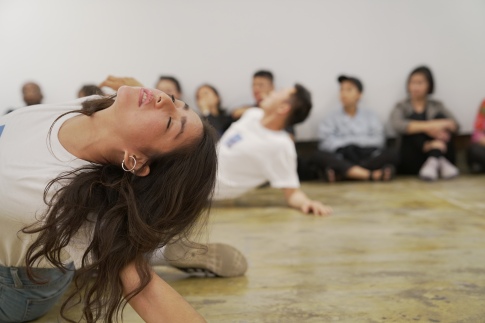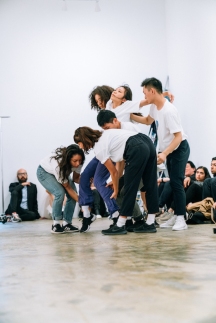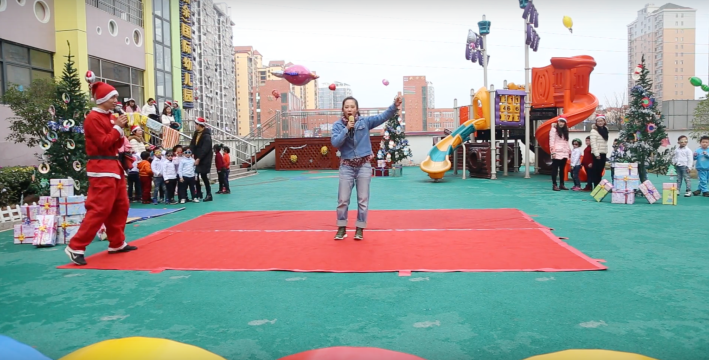Interview: Qinmin Liu
September 25, 2018
By Mary Ma, Barnard College
Choreographer, performer, entrepreneur, Real Player… There isn’t one word or phrase that can encompass the multi-dimensionality of Qinmin Liu and her artistic practice. Her recent performance, QINGNI QINMIN, the second chapter of Real Player 56 at Chambers Fine Art, demonstrated the playful, tender and socially-conscious hue of her work.


Qingni Qinmin (2018) by Qinmin Liu, photography by Taole
During an interview with Qinmin in her studio in Hell’s Kitchen, she talked about her choreo philosophy, her conflicts with identity and institution, and how she plans to undermine the power complex of the art world with her latest entrepreneurial invention, Angelhaha.
Mary Ma: As a professionally trained dancer, how did you get introduced to performance art? What commonalities do you see between dance, choreography, and performance?
Qinmin Liu: My art practice is based on choreography, and to me choreography surpasses the limitations of dance itself—it is also a system for understanding structure. I think having systematically studied dance in China gave me an advantage in terms of technique and flexibility. But when I first moved to the States to study dance as an undergraduate, I was disappointed because what I wanted to learn differed from what was taught at school. From there, I spent a lot of my own time to study my favorite choreographers like Pina Bausch. I studied their dance theories, philosophies, and their understandings of the body and narrative. That’s when I began to investigate the physical movements of choreography through my own research. It opened new doors and channels for me to discover new formats, while dance remains as an important foundation for me.
I’m very proud of the strict physical training I received during my early dance education in China. Contemporary art heavily revolves around asking questions, to the point where artists remove themselves from the art form itself in pursuit of concepts and theories. But technique is really important for me because learning how to dance opened up my body’s connection to the physical world.
Beyond the limitations of dance, I use choreography as my artistic philosophy. Sometimes I feel like I am a person holding a hammer, mechanically pounding on a nail as if all my movements have been choreographed. In fact, everything is simultaneously choreographed and choreographing. Theoretically, a dance starts with a single movement, and through movement you gain momentum. But all my movement-based works came about through images because dance is a very visual medium for me. When I worked on my first big stage performance, I incorporated the projection, costume, music and props into my choreography. To me the stage is a black box with condensations of the essence of society, a miniature of reality. The scenario I employ inside the black box is my grasp of the world outside of it. And this makes my practice a progressive process, from technical to social choreography.
MM: Can you discuss how your project Real Player relates to your feeling of “cultural contradiction”? How has working on this project changed your identity?
QL: Real Player is a long-term research based project for me, and as of yet it still doesn’t have a proper title. It is a book I wrote that organizes and summarizes “me”. I intend to show my complete image with many incomplete fragments of information. In that sense Real Player is more about me finding my own identity. Because I understand my artwork as framed by the philosophy of choreography, my flexibility and malleability allows me to presume a happy life and a positive energy. To say the least, Real Player is a big shifting point in my entire art practice.
Speaking of identity, throughout my career I never labeled myself as a Chinese artist. I realized that the last generation of Chinese artists want the world to know that they are Chinese, and they want to entertain the western artistic sphere. To me they provide an archive for me and I have certainly been heavily influenced by their artistic methods. But when I first came to the States I was still unsure about who I wanted to be, and I still believe that labels such as gender and race are very constraining. I can be friends with people just as human bodies, and in that sense, we are all flexible and controllable. Similarly, I’m not fixed on trying to identify who I am, but I do become envious of those who are confident of their own identities.
One time I saw Isabel Lewis’s performance at DIA Chelsea. She is a Dominican-American artist currently living in Berlin. For the performance, she invited her community members to dance salsa, and she experimented with inserting traditional movements into contemporary space and forms. I was inspired by her philosophy and realized that my own body is preconditioned to be a professional cultural copier of traditional movements. I thought of the 56 ethnic minorities in China, and the many forms of music and dances coming from their cultures. But rarely do you see Chinese artists talking about this diversity. You wouldn’t know what the Miao dance is, or what the Mongolian dance looks like, nor their language, their music, or a lot of other things!
I decided to return to the birthplace of my conception of “culture,” and I took a trip to Fenghuang, where the autonomous minority region is located in the province of Hunan, where I was born. There are only a few autonomous regions left in the increasingly commercialized environment nowadays. When I visited, my best friend was working an office job there, and she introduced me to many of her friends belonging to ethnic minorities who were similar with us in age.
During my stay with her, I spent a week hanging out with her friends. I asked them if they still celebrated their traditional holidays. And most of them replied no. But they would much rather talk about Gucci bags and fashion. This seemed to me a two-fold assimilation. One of Chinese minorities being assimilated into the mainstream Chinese culture, and another of the Chinese being assimilated into the global environment. I felt very conflicted after going with the intention of finding out more about the culture and practices of my own minority group, but ending up with little left of the culture preserved amongst our generation.



Real Player 56 (2017)
Real Player is a long-term project because it records my progress as I attempt to reinterpret and regain confidence in my own culture. Why is it called Real Player? Because I put on the character of a “trickster” in order to insert myself into a system that I wouldn’t otherwise belong in. For me, that is the choreographer taking on the role of a director, and becoming an active decision-maker. I use this playful attitude in my works to challenge institutions.
MM: Speaking of institutions, in your work Dream DIA #1, you critique institutional versus personal decisions from an outsider perspective, can you talk more about this project?
QL: Growing up, I felt the most choreographed in the institution of education. For Dream DIA #1, I wanted to reconnect with my kindergarten experience because it was my earliest contact with society. I did a residency at a local kindergarten, and the principle asked me to choreograph a Christmas eve show for the kids, which I happily accepted. I used the Rite of Spring by Igor Stravinsky and other repertoires as inspiration to direct a fifty-minute performance, which also included a fashion show and a short play.

Still from Dream DIA (2016)
To prepare for the project I interviewed the kids and asked them what their dreams were. For me, my ideas of hopes and dreams first emerged in kindergarten because my teachers asked me what I wanted to be when I grew up. But some of the kids were confounded by the idea of dreams, and I realized they were simply unaware because no one had ever asked them what their dreams were. That’s why I included a segment in the showcase where each kid from the oldest class would come to the front of the stage and share what they’d want to be when they grow up.
This project documents my revisit to an institution that I had grown unfamiliar with. During my time spent at the kindergarten, I asked myself questions about how one’s dreams and hopes can be accomplished within a pre-established institution. That said, although my work begins with a criticism of people and society, I still have a positive attitude and strong faith for the future.
MM: So it is a hopeful and positive work?
QL: Yes, and I think all of my works are hopeful. Through my field research trips I attempt to reconnect with my past. For me, my primary conflict is, how do I use my practice to tie my culture and art together? Coming from a performing arts background, I want to be a holistic and multi-dimensional person and artist. But totally immersing myself into my artistic process produces a lot of internal conflicts. Many of us are used to using criticism as an immediate reaction to everything, but I hope to get away from that and distill it into something that everybody can empathize with. Something that we all feel deep down inside but are unable to scream out. A sort of wishful thinking but also a sense of helplessness coming from within the limitations of society.
MM: You have experimented with the multi-dimensional image you want to produce with you recent project Angelhaha, the name of an airline you founded and also your artistic alter-ego. What ideas prompted this project?

Angelhaha (2018)
QL: Angelhaha is a commentary on the power complex of the art world, of rich collectors taking private jets to go to fairs here and there. Every artist wants to be successful, but there are many unfair things in the art world because it is an institution based on power. That’s why I wanted to make something that would counteract it. I asked myself, would I be able to reshape the art industry?
Angelhaha is about achieving unachievable dreams. An airline? Of course! Because nobody has done it, because it’s “too hard.” Some people assume that I have to be a rich collector to be able pull this off, but that’s not true, I’m an artist. And my slogan is: “Angelhaha will become the most successful business under a female artist’s leadership.”
I’ve always wanted to explore the different functions of an artist, what other limitations can I break and how radically can I do it? What other materials can I use? As an example, I developed a 5-year plan for the Angelhaha airline, and I will use everything and anything as my resource. Because why not! The next project is Angelhaha fossil fuel, Angelhaha sustainable energy, technology, and real estate. The idea is to do and make things that an artist isn’t normally expected to do. I want to set foot in industries that others do not expect me to, to use these industries as artistic mediums. In fact, I feel so lucky to become the first artist to run an airline, it’s super!
In short, the entire act is a performance, and the sky’s my limit.

Exhibition view of Angelhaha at Sichuan Art Institute, China (2018)
I like this idea of a conceptual entrepreneur, of people being creative and breaking through boundaries. And I believe in the potential of my work. I think having faith in potentiality is a very powerful thing, because it pushes me forward despite the criticism, hardships and struggles I experience during my artistic process. It is a powerful force that keeps me positive and hopeful. And that’s why I say, “fly with Angelhaha, fly with happiness”. Angelhaha embodies this kind of spirit for me.
MM: You are constantly redefining what it means to you to be an artist, and redefining what constitutes as an artwork. My last question for you is, how do you see your relationship with your art?
QL: Most of the mediums which I work in make me inseparable from my artwork. I consider myself, the artist, to be the most valuable component of my artwork. A mentor once said to me, and this is the reason why I do performance art after years of training, “Qinmin, you don’t need to do anything, just sit there and that’s it!”
I do a lot of things because I have an art god, a spirit through which I get my inspirations. Sometimes I feel like I’m not really in charge. Rather than deciding for myself what my relationship with my art is, I let the medium decide for me. If I’m making a collage, I’m separated from my work. But if I’m being Angelhaha, it is certainly inseparable because I’m the CEO!
I’ve never given this question much thought before. Because I think of myself as being me, but at the same time I’m using myself as a medium. My level of control for body language and my admiration of my own culture make me feel special and different. When I saw Isabel Lewis’s performance, I was inspired by her infatuation with her own traditional culture. And since I’m already rigorously trained as a professional culture copier, I was inspired by her and thought that this is what I was destined to do.
When people told me that Angelhaha was unrealistic, I was still determined. I had to do it and could not be stopped by anything. The drive, motivation, spirit, whatever you may call it, that energy makes up 1% of my practice. There are other enormous efforts and hard work that goes into it, but I do believe this determination really makes a difference, as cliché as it may sound.
Of course, there are still many things I have to learn. My practice is my learning process, everything I do is a rehearsal. I am in a constant process of rethinking, regrouping and reinventing. So I guess, be humble but be proud .
(The interview was originally conducted in both Chinese and English, and later translated and edited by the interviewer. The responses have been edited with the artist’s approval. All images courtesy of the artist.)
You can visit Qinmin Liu’s website at https://www.qinminarts.com/

